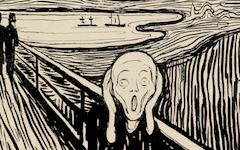Munch’s Old Man Praying (1902)
This 1902 woodcut by Edvard Munch is of an old man praying, at least that's the superficial narrative. Alert viewers will recognize that something else is at work. In the Middle Ages it was common for artists to pray before starting a new project and there is something strange in the old man's pose.
Click next thumbnail to continue
His hands are not open, palm to palm, as in prayer. The only one we can see is actually bent at the knuckles, perhaps as a sign of arthritis. Once seen though, the man begins to resemble an artist on his knees in front of a white support holding an unseen tool in his hand. He looks closely at his work. He could, for instance, be drawing or engraving his hand's shadow on the white rectangle. (Alberto Giacometti also "drew" his shadow in an early self-portrait.) The cloth or curtain on which Munch's man appears to work must then metaphorically be some form of material support, like a canvas or a block of wood.
Click next thumbnail to continue
More Works by Munch
Notes:
Original Publication Date on EPPH: 21 Mar 2014. © Simon Abrahams. Articles on this site are the copyright of Simon Abrahams. To use copyrighted material in print or other media for purposes beyond 'fair use', you must obtain permission from the copyright owner. Websites may link to this page without permission (please do) but may not reproduce the material on their own site without crediting Simon Abrahams and EPPH.





